In a survival situation, foraging for edible plants will be key for a sustainable diet.
But many of these wild edibles are also survival plants, with important properties as medicines, water indicators, and other qualities that can help in an emergency.
Here we look at 34 common wild plants every prepper should know, and learn how they can help you survive.
Wild Plants As Survival Aids
1. Willow
These pale-leaved trees are easy to identify and are commonly known by preppers for the medicinal properties of their bark. But the willow tree has another key role for survivalists: as it only grows near good water sources, it helps survivalists identify water supplies.
The bark of the willow tree contains salicin, a relative of aspirin, which can be used to make an anti-inflammatory and pain-relieving tea. This infusion can also treat bladder infections, as it has diuretic properties. As a gargle, it can treat inflamed gums, and a poultice of willow bark can be applied directly to wounds.
2. Witch Hazel
Witch hazel trees are another of the ancient survival plants, used by early settlers to identify sources of water.
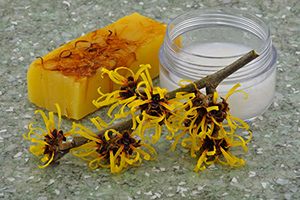
This small tree has unique bright yellow flowers which bloom from late October to early November. The bark and leaves can be steeped to make a treatment for sensitive or inflamed skin, and can also be used as an eyewash for conjunctivitis. Witch hazel can also be used to stop bleeding, either from external wounds or nose bleeds.
3. Cattails
Foraging for cattails will help you identify nearby water sources, as these little plants only grow near water. The dense, cylindrical spikes of the cattail that bear tiny flowers have air chambers inside, making them an effective insulation material for an emergency shelter, while the fluff from the cattail is good tinder.
The cattail leaves are long and flat, lending themselves to weaving for making containers or mats. This species is also one of the wild edibles: the green tops and stalk-bases or rootstock can be grilled or boiled. Cattails are rich in fiber, as well as vitamins A and C.
Related: Delicious Recipes Using Cattails -“The Supermarket of the Swamp”
Wild Plants In Your Emergency Shelter
4. Conifers
Conifers are an important survival plant as their evergreen branches and thick foliage make a good shelter. They may also be added to an emergency fire for warmth in the wild.
5. Grass
Grass can be used as tinder or added to the roof or walls of a shelter for insulation. Along with ferns and other springy plant materials, it can be used to make bedding and shelter-covering in the wild.
Longer grass is woven to make emergency pouches, mats, and even ropes.
6. Pine Needles
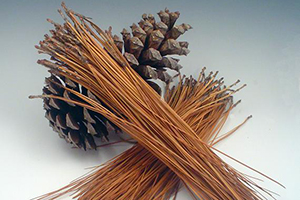 Pine needles are edible plants that are rich in vitamins A and C, but their use goes beyond their role as food.
Pine needles are edible plants that are rich in vitamins A and C, but their use goes beyond their role as food.
Dried pine needles are great for starting a fire, along with lower, dead branches.
Pine gum or resin can also be used as a band-aid to stop wound bleeding.
7. Sagebrush
This species is a useful one to know, especially in areas plagued by insects like mosquitoes. Adding sagebrush leaves to a fire creates smoke or smudge that repels flying insects from the area around your camp.
Rubbing the leaves on the skin can also act as a repellent, but multiple applications may be needed.
8. Birch
Birch trees are easy to identify: the bark is distinguished by horizontal, long openings or lenticels, which separate the bark into thin, papery plates.
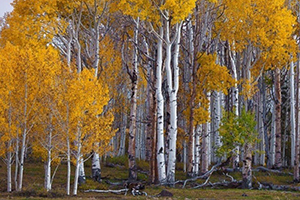
The trees come in grey, silver, yellow, white, and black colors.
Birch makes great firewood, though it burns fast and should be combined with slower burning wood like elms.
Birch bark is rich in salicylates that alleviate pain, similar to willow bark, and its tea has a sweet flavor.
9. Common Hawthorn
This small shrub or tree is characterized by its dull-brown bark with vertical orange cracks. It makes excellent firewood, while the haws and leaves can be made into teas or syrups.
The young leaves and shoots are edible, and used to be called ‘bread and cheese’.
Wild Plants That Are Natural Wound Treatments
10. Plantain
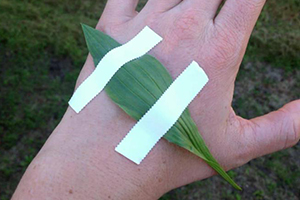 Known as nature’s band-aid, this species could save you from some nasty bites and stings.
Known as nature’s band-aid, this species could save you from some nasty bites and stings.
Preparation of the paste involves chewing on the leaves to make a paste, which can then be applied to insect bites, and stings from bees, wasps, or scorpions.
The compounds in the plantain leaves neutralize the sting and are a quick pain reliever.
Washed plantain leaves could be used as emergency plates or containers for wrapping food. The young leaves and seeds are edible, rich in vitamin K, iron, calcium, and magnesium.
11. Aloe Vera
This tropical succulent is recognizable from its long, gel-filled leaves, which have tiny spines along the edges. The gel can be used topically to treat sunburns, cuts, and scrapes.
To prepare it in an emergency, break off a leaf, cut out the sides to remove the thorns, and “open” it. Carefully remove the gel alone, making sure the green or yellow rind isn’t scraped out too: the rind has powerful laxative properties, so unless that’s the effect you’re after, you need to pay attention to this step!
As well as being used topically, you can combine the gel with water to make a juice. Aloe vera juice fights infections through its anti-inflammatory and anti-fungal activity, boosts immunity, and treats gastrointestinal illness by stabilizing the gut’s internal flora.
Related: How to Make an Antibacterial Sanitizer at Home
12. Comfrey
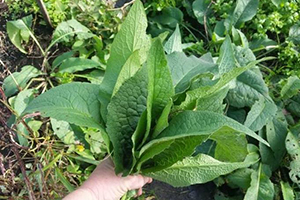 The comfrey plant has been used for centuries for its wound-healing properties.
The comfrey plant has been used for centuries for its wound-healing properties.
The active component, allantoin, is present in the leaves and roots of the plant. It stimulates tissue regeneration and reduces swelling.
The plant has bell-shaped cream or purple flowers, and deep turnip-like roots. The leaves are large, hairy and broad, and intertwine with the stems like bandages. The plant grows in moist meadows and along streams or gullies.
Comfrey should not be taken internally or applied to open wounds, as it can be toxic in high concentrations. Instead, soak cloths in a liquid of cooked, mashed roots, and then apply to bruises, burns, or sprains.
The ground leaves can be applied directly to bruised skin to heal it.
13. Jewelweed
This marshland weed is distinguishable by its orange flowers with red-orange flecks, surrounded by a large pouch-like structure and a spur.
Jewelweed is a natural antidote to poison ivy and nettles, neutralizing the sting and cooling blisters and rashes. Simply crush the purplish juicy stalk to release a slimy paste, and apply it to the affected area.
14. Yarrow
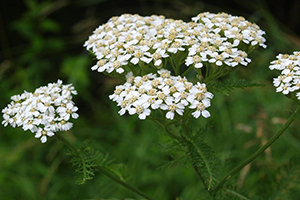 Wild yarrow’s tiny white or pink flowers have a bitter taste that can be used as seasoning, and the crushed flowers and leaves can help clot blood in open wounds.
Wild yarrow’s tiny white or pink flowers have a bitter taste that can be used as seasoning, and the crushed flowers and leaves can help clot blood in open wounds.
The challenge with foraging for yarrow is ensuring it is correctly identified: it looks similar to poison hemlock, which is toxic.
Both plants have similar flowers that grow in clusters, but yarrow has distinctive feather-like, frilly leaves, which smell like fresh pine needles when crushed. They have grooved stems have small, woolly hairs.
Poisonous hemlock, on the other hand, has purple spots along the stems and is generally 3-4 times larger than yarrow.
Related: How To Safely Remove Poison Ivy And Hemlock From Your Backyard
15. Cleavers
Also known as goosegrass, sticky back, or the Velcro plant, these straggling creepers have hooked hairs that help them stick on plants and clothes alike.
As well as its uses as an edible plant, with seeds that can be roasted as coffee substitutes, and young leaves that can be cooked as a vegetable, the plant has medicinal properties too.
The entire plant may be pulped or made into poultices to treat insect bites, stings, and burns. An infusion of the dried leaves and stems also acts as a potent diuretic.
Medicinal Uses of Edible Wild Plants
16. Black Walnut
These nut trees are often surrounded by dead, yellowing plants, as the black walnut tree releases chemicals that are poisonous to nearby plants. The nuts are highly nutritious, containing a great source of fiber, proteins, and folate, as well as high levels of melatonin which is a sleep regulator.
If you are suffering from insomnia, eat black walnuts a couple of hours before bedtime to help re-establish your wake-sleep cycle.
17. Echinacea
This wild plant from the daisy family is also called the purple coneflower, as the petals are purple or pink surrounding a cone-like seed. The juice from this wildflower’s crushed leaves, flowers, or roots boosts immunity and fights infections.
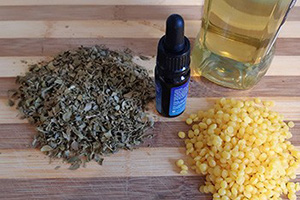
It is usually prepared as a 3:1 tincture, meaning 3 parts of echinacea juice to 1 part of medicinal alcohol (or vodka, if that’s what you have to hand). The use of 20-30 drops fights common cold, bacterial, viral, and fungal diseases.
The root can also be powdered and used on wounds, including oral wounds such as dental abscesses.
The preparation has a numbing effect, along with anti-bacterial properties, which makes it ideal for wound healing.
18. Verbena
Verbena, or vervain, has small, five-petaled flowers that grow in a ball-like cluster. The flowers are lilac, white, pink, or blue.
The leaves and flowers of this wild plant can be steeped to make a tea, which has been used since ancient times for treating respiratory tract diseases, urinary infections, and even seizures. Crushed leaves and flowers can be applied directly to the skin for the healing of wounds, burns, and abscesses.
Related: 53 Plants & Herbs You Can Propagate From Cuttings
19. Lemon Balm
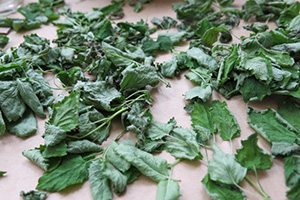 This mint-like herb has a fragrance and flavor like lemons, and this plant has medicinal properties as an antispasmodic and sedative. Lemon balm leaves are chopped and steeped in brandy for 10 days in a dark place, or dried leaves may be steeped in boiling water.
This mint-like herb has a fragrance and flavor like lemons, and this plant has medicinal properties as an antispasmodic and sedative. Lemon balm leaves are chopped and steeped in brandy for 10 days in a dark place, or dried leaves may be steeped in boiling water.
This tea relieves tension-related stomach upsets and headaches and soothes menstrual cramps. Crushed leaves can be used as a topical dressing for insect bites, cuts, and cold sores.
20. Queen Anne’s Lace
This plant is named for the distinctive lacy, triangular leaves, and dull-white, clustered flowers. It is also called wild carrot, and its root is edible raw or cooked, while the flowers, leaves, and seeds make a great meal battered and fried.
Tea made from the root of Queen Anne’s lace is a diuretic and can be used to treat urinary infections.
21. Milk Thistle
Also known as holy thistle or mary thistle, this is an important survival plant: nature’s antidote.
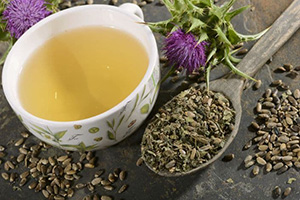
The active component is silymarin, which is most concentrated in the seeds but can also be found in the leaves and flowers.
Silymarin is not water-soluble, so you can’t steep or boil it, but you can grind the seeds or eat them in salads.
Silymarin treats liver disorders and protects the liver from toxins such as that of death-cap mushrooms.
Milk thistle is identified by its white marbling on shiny green leaves. The flower is a bright magenta, seated on top of fleshy, spine-tipped, thick green bracts. The flowers, leaves, and stems have sharp, stiff spines.
22. Burdock
In addition to lending flavor to the classic soda, burdock is a great wild edible food, offering tap-roots and immature flower stalks as fiber- and calcium-rich vegetables.
They also have medicinal properties and can treat stomach problems and joint swellings, as well as acting as a liver tonic.
23. St. John’s-Wort
When you rub the leaves or flowers of this wild plant between your fingers, a deep red oil is released.
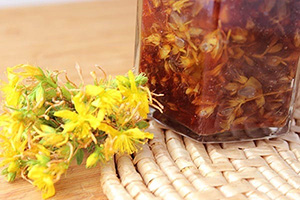
This is due to hypericin, which promotes blood flow, and tannins which have antiseptic properties. To prepare the oil, chop fresh flowers and add them to ½ cup olive oil. Steep for 2 weeks, then filter the red oil, allow it to settle, and decant it to a new bottle. Taken orally, the oil relieves gastric inflammation, gall-bladder pain, and menstrual cramps.
Since it promotes blood circulation, it’s great for treating muscle cramps, bruises, and strains. It also helps heal burns and abrasions and relieves itching from insect bites.
24. Purple Dead Nettle
These ubiquitous weeds are usually found in disturbed soil. The leaves are edible raw in salads and have anti-inflammatory and anti-allergy effects.
25. Nasturtium
Nasturtiums are no stranger to survivalists, as these trailing plants with their brilliant sunset-colored flowers are a good source of vitamins for a wild forager.
Infusions of nasturtium also have antibiotic properties, making them effective cough medicines and wound treatments.
Related: 9 Natural Remedies To Heal Wounds Faster
26. Usnea or Beard Lichens
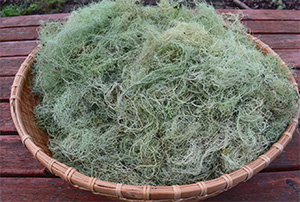 These pale, greyish-green lichens have a tassel-like appearance, growing on barks and twigs of oaks, hickory, walnut trees.
These pale, greyish-green lichens have a tassel-like appearance, growing on barks and twigs of oaks, hickory, walnut trees.
The branches of the lichen are elastic; they come apart when gently pulled to reveal a unique, stretchy white core. You should only harvest fallen usnea.
This can be made into an infusion to relieve phlegm, fever, pain, and sore throat. The taste, however, is very bitter. The lichen can also be used as a compress for applying directly onto injured skin or onto Athlete’s foot.
27. Chickweed
Chickweed leaves, stems, and flowers are eaten raw and may be combined with purslane for a green weed salad. The herb nourishes the glandular and lymph systems.
It also contains saponins, which are a coolant: chickweed salve is used for rashes and bug bites.
Wild Edibles That Are Superfoods
28. Evening Primrose
This is one of the edible plants every prepper should know. The evening primrose, or evening star, is identified by its yellow, bell-shaped flowers that bloom only in the evenings. It is usually found growing in sunny, arid regions.
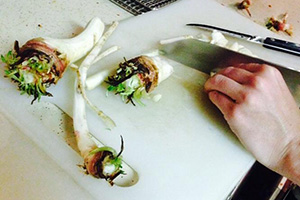
Almost all parts of the plant are edible. You can cook the roots like potatoes, and eat the leaves raw in salads, or cooked like spinach.
The stems and green fruits are peeled and fried; flowering buds and flowers eaten as such, or as garnish in salads.
This wild edible is a rich source of essential amino acids and gamma-linoleic acid.
29. Blackberry
These hedgerow berries are a natural superfood, containing high levels of vitamins, minerals, and fiber.
As well as eating the berries raw, blackberry leaves can be infused to make a mouthwash and is a safe, natural way to treat diarrhea.
Related: 52 Plants In The Wild You Can Eat
30. Dandelion
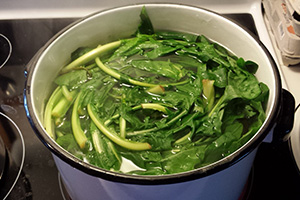 The entire dandelion plant, including its hollow stems, is edible. It is best to eat them before their sunny flowers bloom, and harvest dandelions that grow in deep shade. The roots can be sliced and boiled, or roasted. Flowers are consumed raw, or steeped to make an infusion. Seeds are puffballs that make for a great snack.
The entire dandelion plant, including its hollow stems, is edible. It is best to eat them before their sunny flowers bloom, and harvest dandelions that grow in deep shade. The roots can be sliced and boiled, or roasted. Flowers are consumed raw, or steeped to make an infusion. Seeds are puffballs that make for a great snack.
As well as being rich in fiber, potassium, calcium, carotene, and vitamins, dandelion is a diuretic that helps with UTIs and is an excellent liver tonic.
31. Chicory
Chicory looks similar to dandelion, but has pale lavender or blue flowers, and can grow up to four feet tall. All parts of the plant are edible.
The greens have a somewhat bitter taste which is reduced when they are boiled. The roots can be roasted and mixed with dandelion roots to make a nutritious snack.
32. Purslane
Purslane is a succulent trailing plant with thick, reddish stems. It grows on poor soil and meadows alike.
Purslane leaves can be eaten raw or cooked, and have a high content of omega-3 fatty acids, as well as antibacterial and diuretic properties.
33. Elderberry
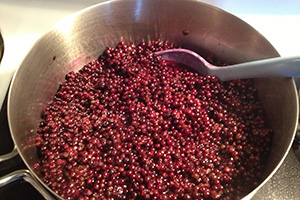 Elderflowers and elderberries are known to be superfoods, rich in nutrients, essential fatty acids, vitamins, and antioxidants. The flowers have immune-boosting properties, are antiviral, and are used to make fever-reducing teas. A brew of elderberries and elderflowers is a powerful flu-fighter.
Elderflowers and elderberries are known to be superfoods, rich in nutrients, essential fatty acids, vitamins, and antioxidants. The flowers have immune-boosting properties, are antiviral, and are used to make fever-reducing teas. A brew of elderberries and elderflowers is a powerful flu-fighter.
Be sure to only harvest the blooming elderflowers and fully ripe berries. The unripe red berries, stems, and leaves are poisonous.
34. Amaranth
Also known as pigweed, the young leaves of this plant may be eaten raw or added to soup. The seeds can be simmered to make porridge or roasted to make a seedy snack. The plant is a great source of protein, minerals and folic acid.
When it comes to sourcing the things you need for a survival situation, you can find materials for shelter, insulation, tinder, nutrition and medication, all growing wild in the great outdoors.
Each of the plants on this list has multiple uses and, with the notable exception of comfrey, all are edible if harvested or prepared correctly.
By familiarizing yourself with these plants and understanding the uses of each part, you can pick up the materials you need efficiently, alongside your routine food foraging.
You may also like:
 Homesteading While You Are Sick For A Long Period Of Time
Homesteading While You Are Sick For A Long Period Of Time
The Killer Tree You Should Never Have In Your Backyard (Video)
How to Get Rid of Bedbugs Using Household Items

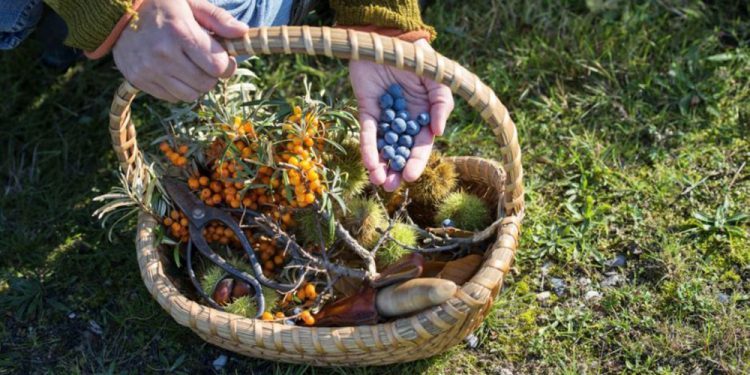













This article would be a good list to use in conjunction with a book with pictures of the plant growing in the wild.
Needs better identifiers to be a stand alone article. Case in point, yarrow. Article says it looks like hemlock, which is very toxic, but says to break open yarrow stalk to see the color of sap. How do ya not get into trouble if ya make a mistake. Not many folks would have nitrile or other gloves on them in a survival situation. Many of the items had no photo included.
I liked the length and variety included in the article, but I think it would need to be used in addition to at least 1 very good book with many photos of the plant.
Thanks for the time you took to write this and Many thanks for having someone proof read it. Makes for much more enjoyable reading!!
Peace,
MadFab
Well colour me chagrined for not double checking the article and my comment. Yarrow and hemlock NOT distinguished by sap, but by smell of the leaves.
Oops. Very sorry for the mistake.
Again, thought article could be a good list to use with a book with more photos.
Peace
MadFab
A few of the above listed where they grew (near water, streams, etc.) but none of them list what region they grow in. For example, plantains only grow in tropical environments. (I had the same concerns about ordering the foragers guide; I don’t need to read up on and study foods that aren’t available in my own climate. I’ve taken a few foraging classes, and even 5 miles closer to the oceanfront makes a huge difference.
Plantain is a green plant related to ornamental hosata which are also edibles. The other plantain is a type of banana. That is a tropical plant. The aforementioned plantain was native to Europe and the Orient. It has naturalized and is found from coast to coast. Here on the western desert areas are the only areas I haven’t seen it growing. It is edible and medicinal. Leaves and seeds are usable but I’ve only eaten the leaves.
Val,
The article discusses a different “plantain” than the banana-like one. The plantain discussed here is thick in my yard in Kansas.
The plantain referred to in this article is a small, low-growing leafy plant. It comes in narrow-leaf and broad-leaf varieties. We mash up the leaves and put them on bee stings to help with the pain and swelling. The leaves can also be used to cover other wounds to aid in healing. I live in northern NY and it grows everywhere.
Curly dock with its elongated leaves is my favorite for soup or boiled vegetable side dish. Yarrow is a small plant with multiple flowering parts a little more than knee-high tall. Poison hemlock is a tree like structure at least 3-6 feet tall that has the famous purple colorations on the stem. Once you see it, you won’t forget it. It is actually attractive and more similar to Queen Anne’s lace than to yarrow.
The plantain in the article is a small herbaceous weed that grows on disturbed ground everywhere, tropical plantain is the roasting banana. Cool that the article mentioned cleavers, always overlooked the leaves steeped in hot water make a tea high in vitamin C.
Internet lists like this are very useful, if a plant interests you just open a new window and search it, there is a world of botanical info available with a couple clicks.
Curly dock is a great plant, the seeds have to be winnowed but are healthy and flavorful, the leaves good as a green or pot herb but in Europe traditionally prepared in a cream sauce, you can cheat and chop them up into a can of cream of mushroom soup.
Good list to learn from.
Burdock is called gobo in Japan and is a staple of the Japanese diet. Japanese farmers grow it as a farm staple the same as daikon or rice.
Burdock, although edible and medicinal is very, very invasive. It has taken me 20 years to eradicate just 50% of the wild burdock growing on our farmstead. The burrs, which stick to any and every thing that brushes up against them, dogs, cats, cows, horses, etc. who then deposit the burrs somewhere else on the property and then viola! a new plant the next year. 🙁 (FYI: NASA got the idea for velcro from the burdock burr back in the early 60’s. That’s how well the burrs stick to everything.)
If you want to grow Burdock, grow it in a controlled location and prune the burrs off while they’re still in their green stage. DO NOT let them dry out. And as Nighthawk said below, a full grown Burdock has a tap root of 3+ feet long, if you just cut the root in half while digging it up, it’ll grow back the next season.
I like burdock root. But have you ever tried digging one up? All 3 feet of it?
Planted in a farmed plot, deep plowed gobo are not that hard to dig up. Growing wild in handpicked earth is another story. Until the EOTW, you can probably buy gobo in Japanese markets and perhaps Korean and Chinese markets. It will have a different name. Use google translate to find the Korean and Chinese words for burdock root.
One of the better Ask a Prepper Articles. Thank you for your effort. Must be hard to shrink so much information into a small format.
A good identification book is critical. For example young Poison Hemlock and Queen Anne’s Lace are very similar. One is good food and medicine the other will let you meet Socrates.
Wild crafting is a useful skill but even with great books and training we get folks visiting our ER for various mishaps.
Also the REASON that farming over took the Hunter Gathers is FOOD Density. It takes a LOT of Pig weed (excellent stuff) over quite an area to equal the calories of a couple of large potatoes. One half hearted potato plant is likely to give you a couple of belly filling meals.
Can I suggest you grab a few grocery store potatoes that have “eyes” on them and plant them everywhere? Those that are missed will over winter at least here in NH and grow into a lovely volunteer potato next year. Potato plants are seldom bothered by deer and I’ve planted them in flower beds with nobody knowing what they were.
Not too long ago I found a potato that had sprouted that had gone overlooked for some period of time. I divided it up into pieces each of which had a sprouting eye. I planted on in the ground and it is growing nicely. Another I planted in a half a wine barrel. I think I planted three eyes. I have a huge potato plant growing in the half wine barrel. Don’t know if I will get any potatoes or not but impressive plant growth.
Left Coast chuck if you make it a point to “Hill” dirt to cover all but about 20% of the foliage you will get a LOT more potatoes as the newly buried leaves will root and generate potatoes. If you don’t you still get a couple of pounds of potatoes. My personal best was 17 pounds from one plant.
The main issues I see with potatoes. Potato virus like what caused the Irish Potato Famine (Yes potatoes was the BULK of their calories and pretty healthy calories) when you MUST move the potato patch at least 10 feet as well as wash your tools to prevent cross contamination. The virus dies off with out a host in 2 years. Irish Small Holders didn’t know or didn’t have anywhere else to plant potatoes SO…
Rodent control, they eat potatoes too. I expect a few rodent nibbled potatoes now and then. Can still be eaten or used for seed stock, your call. A good cat or a ratter dog is a Preppers friend as rodents are a REAL Problem in 3rd world countries.
Enough water. Potatoes like all garden crops need plenty of water. Halfway decent soil is always a good thing. If you have excellent compost in your soil Potatoes will almost Ignore the dreaded Colorado Potato Beatle.
My free range chickens LOVE the Beatles and *might* be why I have few rodent issues as I’ve seen them playing keep away with a rodent in a hens beak. They are Omnivores 🙂
Would be worthwhile to look up the nutrition in a potato WITH the skin on. Vitamin C in good amounts. Most Prepper Foods have very little thus Scurvy is a real situation.
Michael: Thanks for the potato growing tips. I will try mounding the potato plant in the half barrel. Being in the barrel should make it easier to do. I had one branch of the potato plant in plain dirt turned yellow and died off. It already had a tiny potato on the base. I thought I had overwatered it because yellowing of the leave and dying off to my understanding indicates chlorosis which is due to too much water. I may need to do more research. I had the potato plant next to basil. Perhaps that is not a good combination either. I am starting my Farmer Brown act rather late in life but I started my prepping late in life, so I have a lot of catching up to do in the area of plants and animals.
If one reads the book “Paddy’s Lament,” the author states that the reason why potatoes were the main staple of the Irish peasant was because potatoes had no value as an export food item. All during the Irish potato famine Ireland was a net exporter of foodstuffs, including meat and grains.
If I recall correctly, Paddy’s Lament charges that the potato famine was a genocidal move by the English landowners in Ireland to solve the problem of too many Irish farm workers for the land to support. They encouraged emigrating to the U.S. to help alleviate that problem and almost universally refused any aid to the starving Irish tenant farmers. The author also alleges that emigrating to the U.S. on British ships was worse than Africans on blackbirders to the U.S. The ship captain collected full fare upon embarkation. If the Irish immigrant died on the crossing, the ship captain saved that much money in food costs for the trip. The safest passage was on American ships where the survival rate was much higher. Irish families held wakes for the departing sons and daughters. At a time when crossing the ocean was very expensive and international mail service also very expensive, combined with the fact that many Irish tenant farmers could not read nor write, communication was few and far between. It was almost universal that the family would never set sight on the departing son or daughter again in this life.
The author of the book cites statistics to show that the tenant farmer diet of potatoes, mustard greens, the occasional egg and the more occasional piece of chicken (stewer, not Chic-Fil-A) made for a meager, boring, but balanced diet with just enough trace minerals necessary to stave off the vitamin deficiency diseases that were common in the same population in other parts of the world.
Left Coast Chuck, Basil is actually a GOOD Companion planting for root crops.
Has some repellant value against potato bugs, and WHO ever said I have TOO MUCH Basil?
Well actually I HAVE but I give a lot away. SUCH A Problem my Grandmother would say 🙂
The potato with a yellow limb *might* have been broken so the limb died. That’s why you have to be a little careful hilling the plants. The Determinate (like Yukon Gold) vs indeterminate (like Russet) species of potatoes both will respond to hilling but the indeterminate ones are the huge producers for me.
I’d suggest a little research about companion planting to boost your Farmer Brown education 🙂
LCC: Sauerkraut and fruit were mainstays with all northern europeans. Southern Europeans used potatoes as a winter crop, and everyone had them. and, everyone had the same variety that came from a few potatoes brought to Spain from Peru. But, most people experimented with raising them from seed, as well.
Only the North German potato famine came close to what the Irish suffered. That hit in 1857, but they had other crops to back up the loss, like acorns (bury them till spring and even black oak acorns should be sweet enough to eat when they start to sprout). America got hit with a mass of Platzland Germans who spent the family fortune on the trip. The governments and churches in Germany helped pay their way. Most wound up in the Midwest, along the lakes and thrived there. Within a few years, large stone or brick houses were all over the rural areas.
We never learn. Most farmers in the 70s planted one of two types of hybrid corn. When that blighted, the Amish and others were laughing all the way to the bank. Now it’s GMO, and they’re failing, also.
Mulch that potato, and keep us informed how it does. We depend on sweet potatoes and Indian Rush Peas (each plant makes a large ground nut). You might try raising some sunchokes this fall. Mind, they need to be stored for 3 months in cool, damp place, like the barrel, after they die off, or you’ll find why they’re called fart-a-chokes. Storing converts them to sugars.
Meanwhile, after they start to die, plant something that’s short term like green onions. those can be cut off several times and chopped and frozen. niio
For the folks who commented that there is a dearth of literature detailing where certain edible plants grow, the book that Claude reviewed eight topics ago has exactly that information in it. Every plant that the author describes has a small map showing the states where the plant is common.
Some have commented that such books need more pictures. The book Claude described, “The Forager’s Guide to Wild Foods” has pictures of all the plants the author describes. Could they be bigger and could there be more of them? Surely. However, any project like the book in question always has the problem of sales which is influenced by the price point of the book. If the book were printed on 11 x 14 inch, 80 pound clay coated stock with full page photos of the plants in question, would you pay $500 for such a book? I think not. A book like Forager’s is not likely to hit the New York Times best seller list at any price point. And at the price point a large format book with full page color photographs would cost, only a few colleges with large botany departments would order such a book or perhaps a large reference library. For us preppers with limited budgets, a book of 316 pages with a significant number of pages with full color photographs for the price point of this book is a bargain. Grab it while you can.
My biggest problem with plant identification, inasmuch as I am still working my way through Bonehead Botany 101, is knowing what the plant is that I am looking at. I purchased an app for my telephone which is pretty good at identifying plants which is a help, but its library is so large that it has to access it on the cloud which means in an EOTW situation, that information may be lost. I can save individual plants on my phone and for some of the more common plants in my area that I don’t know, I am working on doing that. HOWEVER, even though the app apparently has thousands of plants in its library it still makes mistakes in identifying plants. I asked it to identify oregano that I had planted in my budding herb garden and it identified it as some weed. That’s a pretty significant mistake in my book. It’s not as if oregano is some highly esoteric plant only growing in a limited range.
So I am left with the problem of wanting to identify a plant that the identity is unknown to me, I still have to leaf through the book to see if I can identify that berry and can I eat it. I haven’t looked to see how many plants are identified in The Forager’s book. It appears there are many, most of which are unknown to me. There are ten and a quarter pages of the names of plants with approximately 150 plants on each page. That works out to roughly 1500 plants that can be eaten at one stage or another. Looks like I’ve got a lot of studying to do.
For example, I found this book on Amazon: “Foraging California: Finding, Identifying, And Preparing Edible Wild Foods In California (Foraging Series) by Nyerges, Christopher (June 17, 2014) Paperback Paperback – January 1, 1705
4.6 out of 5 stars 95 ratings
See all formats and editions
Kindle
$16.49
Read with Our Free App
Paperback
$166.00
1 Used from $166.00
1 New from $919.00
Christopher Nyerges is well known in SoCal as the plant guru. Notice the “1 New from $919” I suspect that is a hard cover edition and is probably now a collector’s item. Even the paper back is $166. That give one some idea of how much large edition, lushly illustrated with large format photos can go for —— and more. This is one of the more economical books on Amazon for SoCal vegetation.
https://www.thriftbooks.com/w/foraging-california-finding-identifying-and-preparing-edible-wild-foods-in-california_christopher-nyerges/9050956/?resultid=9395878d-d79d-4d36-9cbd-6f77cfecfad2#edition=21458297&idiq=34062744
Paperback, new, $19.82
Birch can also be tapped just like a maple tree for sap to make syrup.
Black birch. You can make birch beer from boiled branches and root beer from the roots. I don’t think white birch is eatable. At least none of the mushrooms were got from them were. they were always bitter. When boiling down sap, boil meat in it. That’s how we got started making maple syrup. 🙂 Black birch gum is good to chew, too. niio
Gonna get some verbena, and evening primrose and I’m kicking myself for not years ago. We have grain amaranth, and so on. Native black walnuts! Good eating and for the life of me, I’ll never see how a darn squirrel can gnaw into the armor and extract the whole nut meat. niio
Red: Thanks for the tips. I have been growing green onions for about two years now and have good success with them. I have also had moderate success with red onions and am about to start with a yellow onion which I have been sprouting on the windowsill in the kitchen. It goes in the pot later this afternoon.
My latest venture is potatoes. The one that went to sprouts was a russet. I am hoping for success with potatoes. If I have success with them, sweet potatoes are my next venture. I have enough long life Vitamin C tablets to keep scurvy at bay for a couple of years should the end of the world happen tomorrow. I favor the dense vegetables like potatoes and sweet potatoes to provide maximum calories while requiring minimal space for growing. They also last a long time stored well. I might try cabbage if I have success with sweet potatoes. I am reading up on sprouting right now as that can be grown in limited space and here is SoCal should make a year round crop. We haven’t had frost here where I live since sometime in the late 60s, so I don’t have to worry about winter freezes.
LCC: During the great depression (FDR’s) a lot of people subsisted on sauerkraut and other natural pickles. Probiotics raise digestible protein (yeast is over 34%) and quite a bit of vitamins. Vit. C is a major the bacteria make. https://bodyecology.com/articles/most-effective-vitamin-c-php/
From what I’ve seen, all it takes is one loony global warming nut and all of a sudden palm trees and banana stalks are breaking over in the blizzard. God is laughing, again. 🙂 niio
Only 16 of the plants in this list grow within 100 miles of here. Still its an interesting article. I collect seed or buy seed with hopes of getting more wild edibIes and medicinals to grow here.
When my Dad was studying botney ect. While working toward becoming a dietitian he taught me many wild edibles. Somethings he’d foraged while growing up and others he’d learned during the depression. Mom also took me foraging. Often dinner was what we found. Dads instruction on how to recognize plant families was helpful but the main one I still remember is the cole family. Easily recognized flowers. All of them are edible. You may know them as cabbage family.
Cleaver is also known as bedstraw. It is considered an invasive species on Washington State.
Also, when I looked it up, there was a note that some people are allergic to it and should not consume it.
Here’s a link to a Welsh dish called “dock pudding”. Burdock leaves are combined with oatmeal and other ingredients to make a stiff batter that’s fried in bacon fat or butter and served as a breakfast dish. There are also other wild sourced foods on this website that look interesting. Enjoy.
https://hisforhomeblog.com/food/whos-heard-of-dock-pudding/
I’d like to put my vote in for Storksbill and Cranesbill (both in the geranium family). The young plants are delicious raw or cooked. Horses go crazy for them, too. The dried seeds are a bit of a problem because they are hard, pointy, and will drill (literally) into anything if they encounter moisture.
In Northern California, there’s always wild fennel; delicious to munch on, young stalks can be cooked as well, and easily identified (while green). If you harvest the seeds, you’d better know the difference between fennel and poison hemlock. The plants look alike when dry. In fact, many of the members of the parsley family look similar when still green, and almost indistinguishable when dry. It’s a wonder that more people don’t get sick every year from picking the wrong seeds.
Ditto on purslane. It’s even sold fresh in some markets. Good addition to soups.
Let’s not forget miner’s lettuce. Yum!